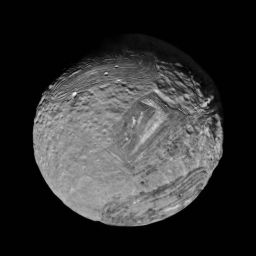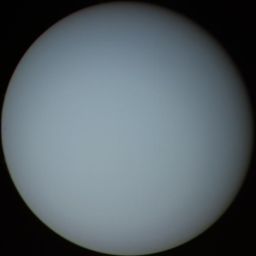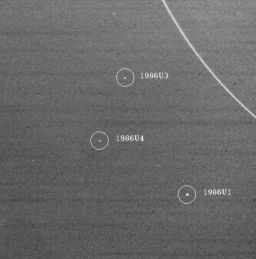Emily Lakdawalla • Jan 23, 2009
365 Days of Astronomy Podcast: Voyage Past the Sideways Planet
In the first game of a Planetary Society doubleheader of contributions to the 365 Days of Astronomy Podcast, my latest show, airing today, looks back to Voyager 2's encounter with Uranus, which happened 23 years ago tomorrow, just four days before the Challenger disaster. Tomorrow, Jim Bell will be looking back through five years of living vicariously on Mars. You can listen to my show here, and I've copied the transcript below; but first, here are more related links than you probably want to see on the topic of the Voyager 2 Uranus encounter, and what we've learned about the sideways planet since then.Here's a news article I wrote in 2004 about how Uranus isn't boring anymore. And another about the discovery of new rings around Uranus in 2005. And a blog entry explaining how many moons we've discoverd there. And a blog entry explaining how Uranus got its tilt. And a couple of entries on Uranus' equinox on December 7, 2007. And one explaining the significance of the August 16, 2007 ring plane crossing. And a recent blog entry on how to pronounce "Uranus" without too much embarrassment.
The Voyager image catalog has attracted lots of attention from the "citizen scientists" who enjoy playing with archived space mission data. Notably, amateur Ted Stryk discovered previously unseen details in Voyager 2 images of Uranus' moons, in areas very faintly lit by sunlight that reflected first off of the planet. One of his images is at right; read the full story about these images, and see more of them, in the blog. To see what Ted had to work with, check out my recent blog entry on the full catalog of Voyager 2 images of Uranus' moons.
There have also been several Planetary Radio podcasts touching on Uranus, especially its recent activity as its equinox approaches:
- Studying the Rings with Imke de Pater, May 14, 2007
- Checking the Weather on Uranus by Radio Telescope with Mark Hofstadter, October 23, 2006
- Turning the Spotlight to Uranus and Neptune with Heidi Hammel, July 17, 2006
- Uranus and Neptune take Center Stage with Heidi Hammel, December 19, 2005
Not a lot was known about Uranus before Voyager 2's flyby. We knew it was greenish-bluish in color, and that it was sideways. We knew of five moons, but they were only specks in our telescopes. We didn't know how fast the planet rotated, exactly what it was made of, or whether or not it had a magnetic field. Its rings had only been discovered less than a decade before the encounter. So Voyager 2 had the opportunity to answer lots of questions. But it had to do that in a close encounter period lasting only six hours, and with a spacecraft that was never intended to be used in such a dim environment, so far from the Sun.
The distance created lots of problems. Like all optical cameras sent to space, Voyager 2's needed sunlight to light up Uranus, its rings, and its moons. But Uranus is twice as far from the Sun as Saturn. And unlike Saturn, which has bright clouds, bright icy rings, and bright icy moons, Uranus is darker, with very dark rings and very dark moons and very little contrast among the faint features in its clouds. In order to take good pictures of objects in the Uranian system, Voyager 2 had to use camera exposures that were 15 seconds long or longer. Have you ever tried to take a photo in a dimly lit room without using your flash? You know what happens: the image blurs as your hand jiggles during the long exposure. Voyager doesn't have a tripod either, and in the frictionless environment of space, every tiny action of the spacecraft -- even starting and stopping its tape recorder -- caused wiggles and wobbles in its motion, blurring images. In the years before the encounter, the scientists and engineers had to develop new ways of using the old spacecraft to compensate better for those wiggles and wobbles from inside, and to rotate the spacecraft slowly while images were taken to compensate for the motion of the moons.
The dim light wasn't the only technical challenge. It was also hard to receive the data from a spacecraft outfitted with only a 20-watt transmitter that was broadcasting from 2.5 billion kilometers away. NASA had to upgrade its Deep Space Network, building secondary 35-meter radio antennas next to its 64-meter antennas at Goldstone, Canberra, and Madrid, and use the two antennas at each station as a phased array.
The bullseye orientation of the planet also caused planning headaches. It was nearly summer at Uranus, and that meant that the southern hemispheres of Uranus and all its moons were pretty much always sunlit, while the northern hemispheres were in permanent shadow. So, no matter how tricky the mission got in planning Voyager 2's trajectory, the spacecraft was doomed to be able to photograph at most half of each body, with the northern halves destined to remain terra incognita until some future mission was sent to explore the system in a different season. What was worse, the bull's eye orientation meant that planners could only achieve a close encounter with one of Uranus' moons, Miranda, the closest one to the planet. All the other moons were imaged at great distances.
But, with all these challenges, Voyager 2's six-hour close encounter with Uranus revolutionized our understanding of the planet and its rings and moons. The close-up pictures of the planet itself were a strange combination of awesome and disappointing -- awesome for being the first detailed sight of an unimaginably distant yet giant world, disappointing for the bland serenity of the nearly featureless azure atmosphere.
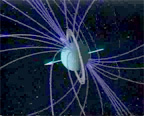
NASA Voyager Science Summary
Uranus' Magnetic Field
The magnetic field of Uranus is strongly tilted with respect to the planet. An animation is available (.mov, 1 MB)What Voyager 2 could learn from its studies of the atmosphere was strange, too. Although it looked bland and featureless in optical images, clearly there were things happening below the surface. Because of Uranus' extreme tilt, its poles receive much more solar energy over the course of a year than its equatorial regions do, yet Voyager 2 found that the upper atmosphere is pretty much the same temperature from pole to equator.
The moons, hitherto exceedingly faint pinpricks of light, leapt into being as distinct worlds. Fortuitously, the most fascinating of the moons turned out to be the one that Voyager 2 passed nearest, Miranda. During a mission that returned many surprising images from faraway places, the Voyager 2 pictures of Miranda stand out as some of the weirdest. Half of Miranda is covered by bland, old, cratered terrain, but the other half is split into three rectangular regions of bright and dark mountains sculpted into some of the steepest slopes found anywhere in the solar system. At the time, scientists theorized that Miranda had been smashed apart and then reassembled, so its surface was a weird jumble of insides and outsides. Now, though, the most popular explanation is that Miranda was frozen in the act of differentiating, while attempting to turn itself inside out.
In all, the encounter was a triumph. But few people on Earth could enjoy the triumph when it happened, because just four days after Voyager 2 swung past Uranus came one of NASA's most awful moments: the horrific explosion of the Space Shuttle Challenger upon liftoff.
I was only ten, and in the sixth grade, when that happened. I was not one of those schoolkids who were watching the liftoff live, but I'll never forget the moment when a seventh grader, whose class had been watching, burst into my Latin class and shouted "the space shuttle just blew up!" Within minutes it seemed like the entire school had crowded into the seventh grade history class, where we watched TV for half an hour, seeing the twisted trails of smoke slowly dissipate, and listening to the aghast commentators groping for some sort of way to communicate the horror of what had just happened.
Alhough I didn't think about it so explicitly at the time, I'm quite sure now that the juxtaposition of the triumph of Voyager 2 and the tragedy of Challenger strongly influenced my future interest in robotic space exploration. I thought about the seven astronauts who had died so horribly, and wondered, why? Where were they going? What were they doing? Was it worth the risk of human life? At the same time, there was a pilotless spacecraft, going where no human could hope to go within my lifetime, revealing the unknown to all of Earth for the first time, putting everyone who looked at those amazing images on an even footing; Voyager 2 made astronauts of all of us.
And its journey wasn't over yet. The Uranus flyby flung Voyager 2 on a trajectory that would take it to the next unexplored planet, Neptune, in 1989. After that, it took one, last, loving look at the entire solar system in a panoramic view, before it shut off its cameras for good. But it's still flying, now examining the interstellar space beyond the influence of our Sun, exploring where no human can go.
As for Uranus, no spacecraft has visited it since 1986, nor is there any future mission currently on the books. But it hasn't been ignored. In the past decade, new technology called adaptive optics has enabled Earth-based telescopes to obtain sharper images of the planet than ever before. The timing was great. One Uranian year is 84 Earth years long, so its seasons last 21 years apiece. Voyager was there 23 years ago, near the height of southern summer. So 2007 was one season later, the Uranian equinox. For a planet as tilted as Uranus, the equinox is a big deal, the only time during the year when sunlight reaches all of the planet. Astronomers have recently discovered that the atmosphere of Uranus is not nearly as boring as Voyager 2 images suggested. In the years leading up to its equinox, new cloud bands and storms have erupted there and then dissipated in days, making Uranus as dynamic as Saturn or Jupiter. I have plenty of Voyager 2 and telescopic images posted on The Planetary Society's website; visit us at planetary.org, and thank you for listening.
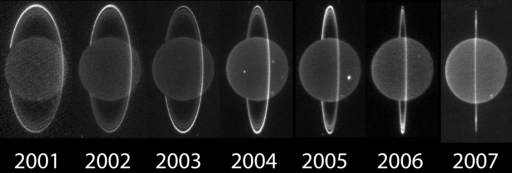
Imke de Pater, Seran Gibbard, Heidi Hammel / W. M. Keck Observatory
Keck's Changing View of Uranus
From 2001 to 2007, Uranus's motion around the Sun has brought spring to its northern hemisphere. These images taken through Keck II's K prime filter. The images also show how the Adaptive Optics system has improved over time. In the final image, the planet seems brighter because Earth (and Keck) are on the dark side of Uranus' rings; when the image was brightened to make the rings more easily visible, the planet was also brightened.The Time is Now.
As a Planetary Defender, you’re part of our mission to decrease the risk of Earth being hit by an asteroid or comet.
Donate Today

 Explore Worlds
Explore Worlds Find Life
Find Life Defend Earth
Defend Earth


